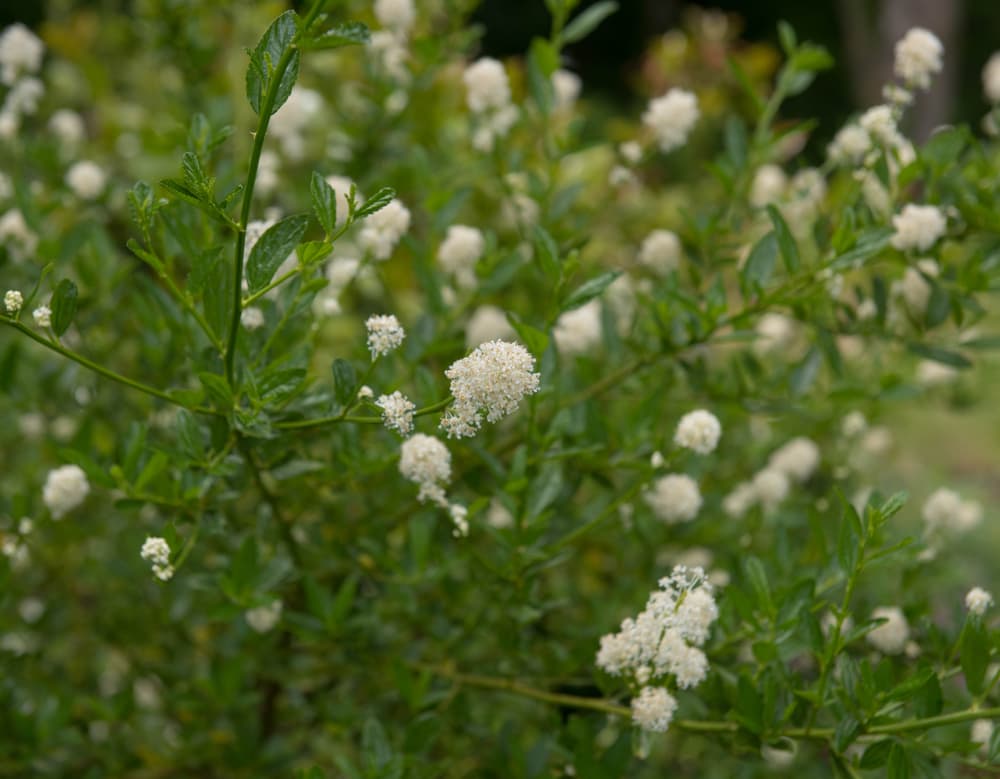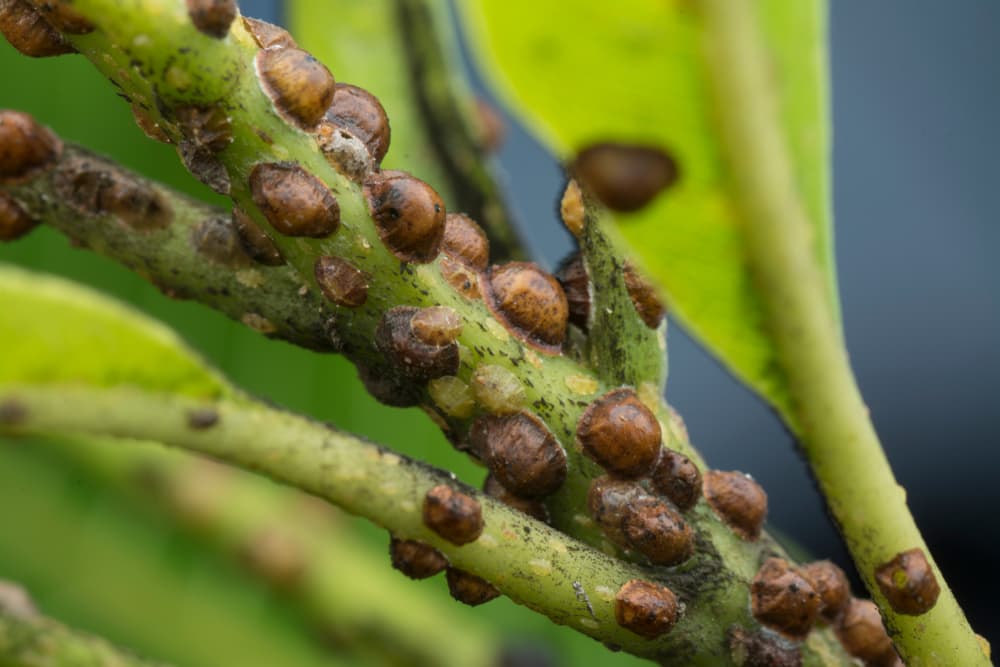Ceanothus ‘California Lilac’ Growing Guide: This Plant Is An Absolute Bee Magnet!

SHRUBS > CEANOTHUS
Chris is a gardening writer and nature enthusiast. He graduated from Oxford Brookes University in 2022 with an MA in Psychology. Chris works with the Leeds Green Action Society, helping their food cooperative by growing various fruit and vegetables on their two allotments in Hyde Park, Leeds.
Reviewed By PETER LICKORISH

Peter is a Horticulture Lecturer and self-employed Horticulturist, with a passion for diverse areas of the industry - from garden design to the science behind plant growth and propagation. He has completed the Royal Horticultural Society’s Master of Horticulture (MHort) Award and lectures on RHS courses at Bedford College.
IN THIS GUIDE
Break down the Greek word that gave rise to the name of this plant, and you’ll find it translates to “spiny plant” – a label that sidesteps the truly defining characteristics of the flower: big panicles of colourful florets, which bring bold bursts of beauty to any garden.
If you’re looking for an attractive and versatile plant, then look no further.
“The glossy leaves and the hum of bees on pale blue flowers are the main highlights of Ceanothus for me,” says Horticulture Technician Peter Lickorish.
Varieties of ceanothus flower in spring, summer, and autumn.

It has glossy leaves, with flowers in a range of calming colours – and is suited to hedges, ground cover, or even as a source of scent in your garden.
Overview
| Botanical Name | Ceanothus |
| Common Name(s) | Californian Lilac; Soap Bush; Buckbrush |
| Plant Type | Shrub |
| Native Area | United States |
| Hardiness Rating | H4 (for most species) |
| Foliage | Evergreen |
| Flowers | Small blue, white or pink flowers in terminal clusters |
| When To Plant | March, April, May |
| Flowering Months | May, June, July, August, September, October |
Sunlight
Preferred
Full Sun
Exposure
Sheltered
Size
Height
1.5 – 2.5M
Spread
2.5 – 4M
Bloom Time
Spring, summer and autumn flowering species
Soil
Preferred
Chalk, loam, sand
Moisture
Well drained
pH
Neutral to alkaline
As we said earlier, the name translates simply as “spiny plant” in Greek.1Ceanothus, Versatile California Native. (n.d.). ANR Blogs. Retrieved March 14, 2023, from https://ucanr.edu/blogs/blogcore/postdetail.cfm?postnum=49058
You’ll also see common names used, including ‘Soap Bush’, ‘California Lilac’ (alluding to the west coast of America, where this plant is most diverse) and ‘Buckbrush’.2Ceanothus. (n.d.). California Native Plant Society. Retrieved March 14, 2023, from https://calscape.org/loc-california/Ceanothus(all)/np-1/vw-list?view_style=list

The genus contains about 55 species of plant, ranging in size from shrubs to small trees.3Ceanothus. (n.d.-b). Oregon State University. Retrieved March 14, 2023, from https://landscapeplants.oregonstate.edu/ceanothus
Originally hailing from North America, from coastal areas to mountaintops, ceanothus has become a popular candidate for British gardens thanks to its versatility and beauty.4Ceanothus thyrsiflorus. (n.d.). The University of Texas at Austin. Retrieved March 14, 2023, from https://www.wildflower.org/plants/result.php?id_plant=CETH
Why Grow Ceanothus?
This genus of plants includes a spectrum of cool and pastel colours, and offers enough variety in preferred growing conditions that most gardeners will be able to find at least something compatible with their outdoor space.
What’s more, the majority of Ceanothus are rated as having hardiness of H4, meaning they can thrive in temperatures down to -5°C – making them great for most of the UK.

I actually have a Ceanothus at the bottom of my garden that has been there since we moved in (see the picture above).

During its main flowering season in late spring and early summer I have never seen so many bees on one plant – the tree itself seems alive with a constant ‘buzz’ from the sheer number of different types of bees harvesting pollen from its fuzzy blue blooms.

It makes me really happy to know that this one plant is providing so much to the local ecosystem – especially our pollinators.
Not only that but we also get a second flowering in late autumn which, while not quite so prolific, provides a welcome burst of late colour in the garden.
How To Grow Ceanothus
The growing and care tips given below are indicative of some plants in the genus, but not all of them.
With so many varieties available, we recommend checking the specific requirements of each and every ceanothus you decide to grow.
Where To Grow
Hailing from the West coast of America, this plant can tolerate a lot of sunlight.
For best growth, plant somewhere with full sun exposure, and with a little shelter against the harsher winds and frosts they’ll experience in the UK.

Somewhere facing west or south should do the trick.
In terms of soil, the general rule is most but well-drained, with neutral or alkaline pH level.
Some varieties can tolerate acidity, but as mentioned, double-check the specific varieties you’re planning to grow to avoid disappointment.
Planting
Best planted in spring to avoid frost damage while it establishes, or if you have particularly well-draining soil, you can plant in autumn.
Digging in leaf mould or well-rotted manure aids with drainage on heavy soils, and increases the chance of your Ceanothus taking.
Ceanothus Care
Fertilising
Ceanothus rarely require feeding, but can benefit if you decide to do it.
Sprinkle balanced fertiliser around the base, leaving a ring of around 3-5cm from the plant.

This helps to avoid rotting, which can occur if you fertilise too close to the plant.
Watering
You’ll want to water your ceanothus fairly frequently during dry weather until the roots are established, which can take a few years.
When your ceanothus is established, it won’t need much watering unless you’re experiencing drought conditions.
Training
Certain varieties of this plant are well-suited to training up walls and other vertical surfaces, such as Ceanothus azureus.
Use twine to gently tie new shoots onto supporting structures, like trellises or chicken wire.

This should encourage vertical growth without causing damage to the plant.
Common Problems
I find that my Ceanothus is generally free from pests and diseases, making it a forgiving choice for gardeners who don’t have lots of time to spend monitoring the health of their plants.
There are a couple of things to keep an eye on, however.
Exposure Damage
As alluded to, this plant’s West Coast origins mean it may not cope so well with some of the harsher conditions the UK throws at it.
If you’re not able to find a sheltered location for your ceanothus, try to control against damage from wind and frost.
Wind scorch is caused by cold winds pulling moisture from plants and soil, putting them in a position where they struggle to replace the water quickly enough.
As a result, leaf edges – or entire leaves in particularly bad cases – may turn brown.

If your ceanothus is growing in an exposed position and strong winds are forecast, do your best to erect a windbreak – either manmade or in the form of another plant.
I am lucky in that my Ceanothus is growing at the end of our garden where it is very well protected from the wind by the surrounding fencing and houses.
The area around its base is also mulched extensively to protect the roots of the plant.
Though ceanothus is hardy, it will struggle in some UK temperatures.
If you live in a particularly exposed area, using horticultural fleece to cover the plant, as well as mulch, or some other insulating medium around the root of the plant can protect against frosty spells, and pruning damaged sections can control the damage caused.
Scale Insects
These pests like to make their home on ceanothus leaves and stems, feasting on the sap contained within.
You’ll see bumpy ridges on leaf undersides, and possibly black fungus atop the leaves that grows on the insects’ excretions.

At first you can remove the insects by hand, although this won’t work against higher numbers.
You can encourage predators such as ladybirds to visit your garden to eat the insects or, failing that, a range of pesticides are available to curb more persistent visitors.
This colourful and striking plant, with its bundles of brightly coloured flowers vying for attention and providing beautiful backdrops for medleys of other flowers, makes a fine addition to any garden.
We’re sure you’ll enjoy incorporating them into yours!
References
- 1Ceanothus, Versatile California Native. (n.d.). ANR Blogs. Retrieved March 14, 2023, from https://ucanr.edu/blogs/blogcore/postdetail.cfm?postnum=49058
- 2Ceanothus. (n.d.). California Native Plant Society. Retrieved March 14, 2023, from https://calscape.org/loc-california/Ceanothus(all)/np-1/vw-list?view_style=list
- 3Ceanothus. (n.d.-b). Oregon State University. Retrieved March 14, 2023, from https://landscapeplants.oregonstate.edu/ceanothus
- 4Ceanothus thyrsiflorus. (n.d.). The University of Texas at Austin. Retrieved March 14, 2023, from https://www.wildflower.org/plants/result.php?id_plant=CETH
